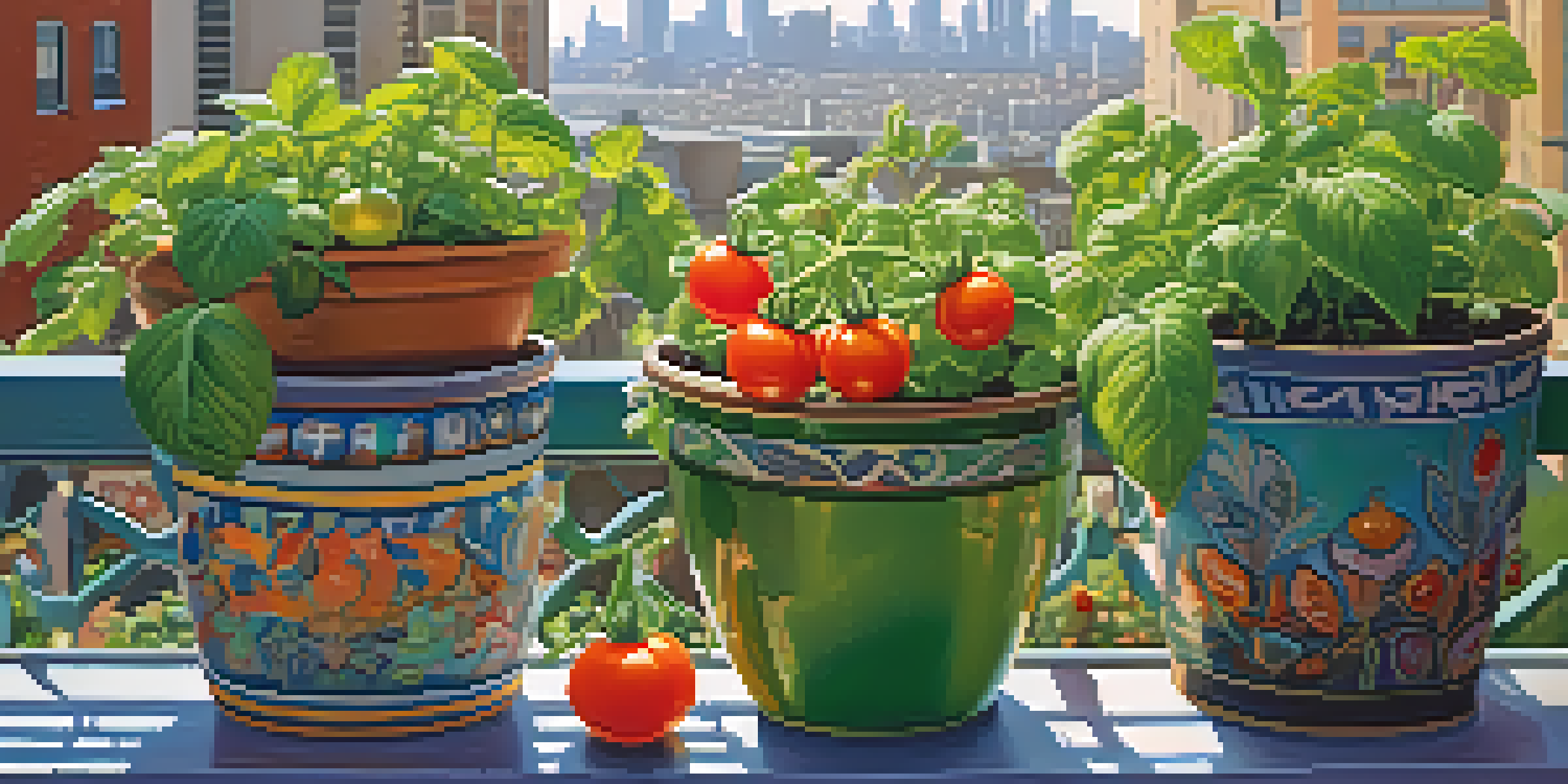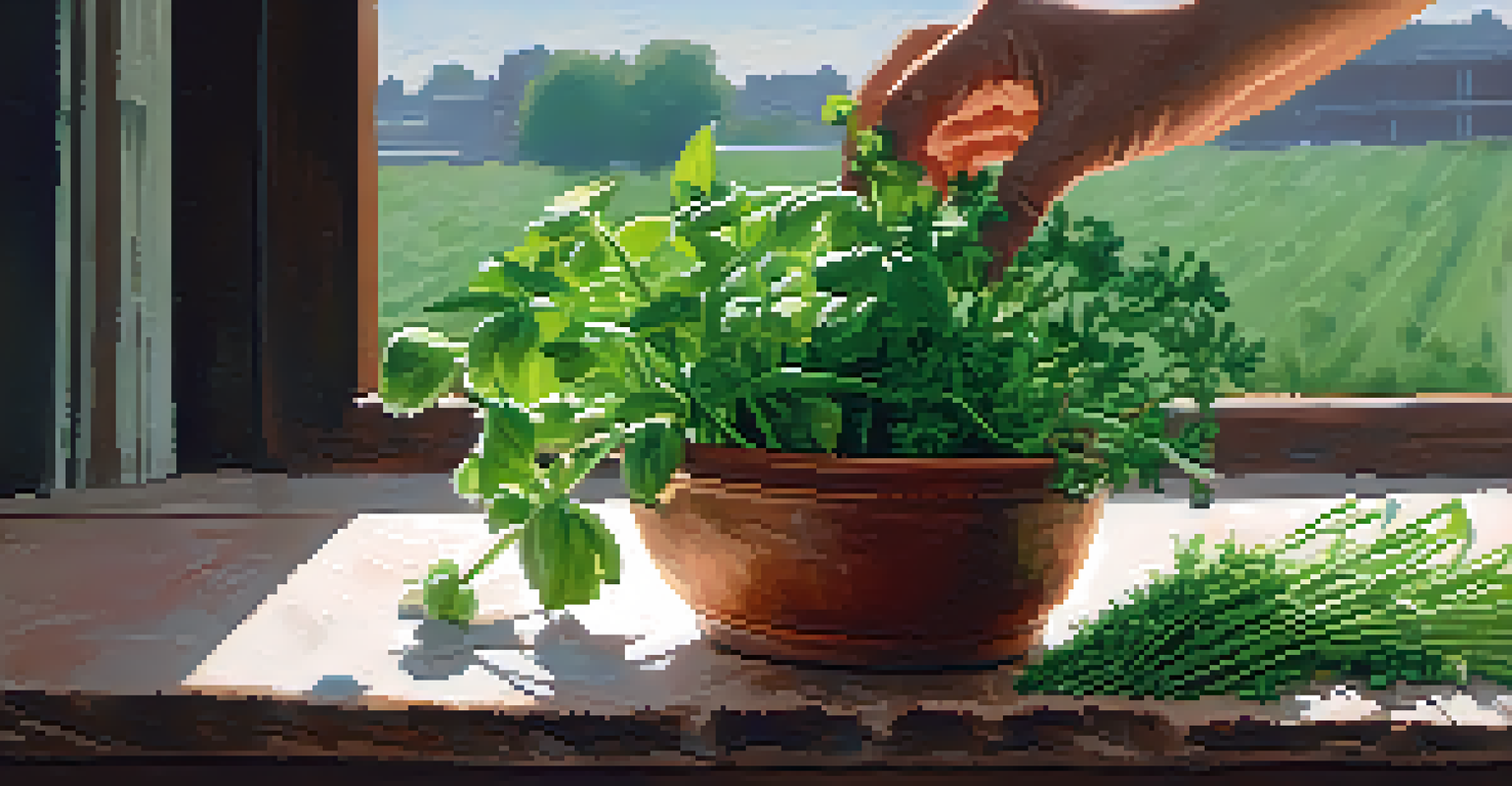Urban Gardening: Growing Food in Limited Spaces

Understanding Urban Gardening and Its Benefits
Urban gardening is the practice of growing food in city environments, often in limited spaces. This can include anything from balconies to small backyards, and even rooftop gardens. With rising food prices and a growing interest in sustainability, urban gardening offers a practical solution to food insecurity while promoting healthier eating habits.
The garden suggests there might be a place where we can meet nature halfway.
Not only does urban gardening provide fresh produce right at your doorstep, but it also contributes to environmental well-being. Plants help improve air quality, reduce urban heat, and support biodiversity by providing habitats for various species. Additionally, gardening can serve as a relaxing hobby, helping to alleviate stress and enhance mental well-being.
As more people embrace this lifestyle, community gardens are becoming increasingly popular. These shared spaces foster a sense of community and collaboration, where neighbors can connect over their mutual love for gardening and sustainable living. Ultimately, urban gardening not only transforms our food systems but also strengthens social ties.
Choosing the Right Space for Your Garden
The first step in urban gardening is selecting the right space. Whether it’s a balcony, windowsill, or rooftop, assess how much sunlight the area receives throughout the day. Most vegetables and herbs thrive in at least six hours of direct sunlight, so this is essential for a productive garden.

If you have limited outdoor space, don’t worry! Indoor gardening is a great alternative. You can utilize vertical gardening techniques, such as wall-mounted planters or shelving units, to maximize your space. Hydroponic systems can also be an efficient way to grow plants indoors without needing soil.
Urban Gardening Boosts Sustainability
Urban gardening not only provides fresh produce but also enhances environmental health and community connections.
Before you start planting, consider the conditions of your chosen space, such as wind exposure and access to water. Each plant has its own specific needs, and adapting your garden to meet these requirements will lead to better growth and yields. This thoughtful planning sets the foundation for a thriving urban garden.
Selecting Plants Suitable for Small Spaces
When it comes to urban gardening, choosing the right plants is crucial, especially in limited spaces. Opt for compact varieties or dwarf versions of popular fruits and vegetables, which are specifically bred to thrive in smaller environments. For example, cherry tomatoes and mini bell peppers are excellent choices for container gardening.
To plant a garden is to believe in tomorrow.
Herbs are another fantastic option for urban gardens due to their versatility and small size. Plants like basil, mint, and chives can easily fit on a windowsill while adding flavor to your meals. Plus, growing your own herbs is a rewarding experience that enhances your culinary skills.
Consider companion planting as well, where certain plants are grown together to benefit one another. For instance, planting basil alongside tomatoes not only saves space but can also improve the flavor and growth of both plants. This strategic approach can maximize your garden’s potential.
Essential Gardening Techniques for Success
To make the most of your urban garden, it’s important to adopt effective gardening techniques. Start with container gardening, which allows you to control soil quality and drainage easily. Choose pots that are large enough for your plants and ensure they have adequate drainage holes to prevent waterlogging.
Another key technique is vertical gardening, which involves growing plants upward instead of outward. This can be accomplished using trellises, hanging planters, or stacked containers, saving valuable ground space while still yielding a bountiful harvest. Vertical gardening not only maximizes space but also adds visual interest to your garden.
Choosing the Right Space Matters
Selecting an optimal gardening space with adequate sunlight and conditions is crucial for a successful urban garden.
Don’t forget about soil quality, as healthy soil is vital for plant growth. Invest in high-quality potting mix and consider adding compost to enrich nutrients. Regularly check your plants for pests and diseases, and be proactive in addressing any issues to ensure a thriving garden.
Maximizing Yields Through Companion Planting
Companion planting is a fantastic strategy to maximize your urban garden yields while enhancing biodiversity. By planting compatible species together, you can improve growth, deter pests, and even enhance flavors. For instance, pairing carrots with onions can help keep pests away while allowing both plants to thrive.
Another popular combination is planting marigolds alongside vegetables, which can repel harmful insects and attract beneficial pollinators. This natural pest control reduces the need for chemical pesticides, making your garden healthier and more sustainable.
Experimenting with companion planting can be a fun way to learn more about plant relationships, and it can lead to surprising results. By observing how different plants interact, you’ll become more knowledgeable about your garden’s ecosystem and how to nurture it effectively.
Watering and Maintenance Tips for Urban Gardens
Proper watering practices are crucial for urban gardening success, especially in containers that may dry out quickly. Establish a consistent watering schedule, checking soil moisture levels regularly to ensure your plants are getting the right amount of water. Remember, overwatering can be just as harmful as underwatering.
Consider using self-watering pots or a drip irrigation system if you’re often busy or forgetful. These methods can help maintain consistent moisture levels while reducing waste. Additionally, mulching around your plants can help retain soil moisture and suppress weeds, making maintenance easier.
Companion Planting Enhances Yields
Utilizing companion planting techniques can maximize yields, improve growth, and reduce pests in your urban garden.
Regular maintenance is key to a flourishing garden. Take time to prune, deadhead, and remove any diseased or pest-infested plants to promote healthy growth. By staying on top of these tasks, you’ll create a vibrant urban garden that can thrive through every season.
Harvesting and Enjoying Your Urban Garden Produce
After nurturing your urban garden, it’s time to enjoy the fruits of your labor! Harvesting your produce at the right time is essential for optimal flavor and freshness. For most vegetables and herbs, this means picking them when they’re fully grown but still young and tender.
Don’t be afraid to experiment in the kitchen with your freshly harvested ingredients! Homegrown produce often tastes better than store-bought, and you can try new recipes or get creative with flavors. Sharing your bounty with friends and family can also be a wonderful way to connect and celebrate your gardening journey.

Moreover, consider preserving your harvest through canning or freezing to enjoy your garden’s flavors long after the growing season ends. This not only minimizes waste but also allows you to savor your hard work throughout the year. Urban gardening truly transforms your relationship with food, making it more rewarding and fulfilling.